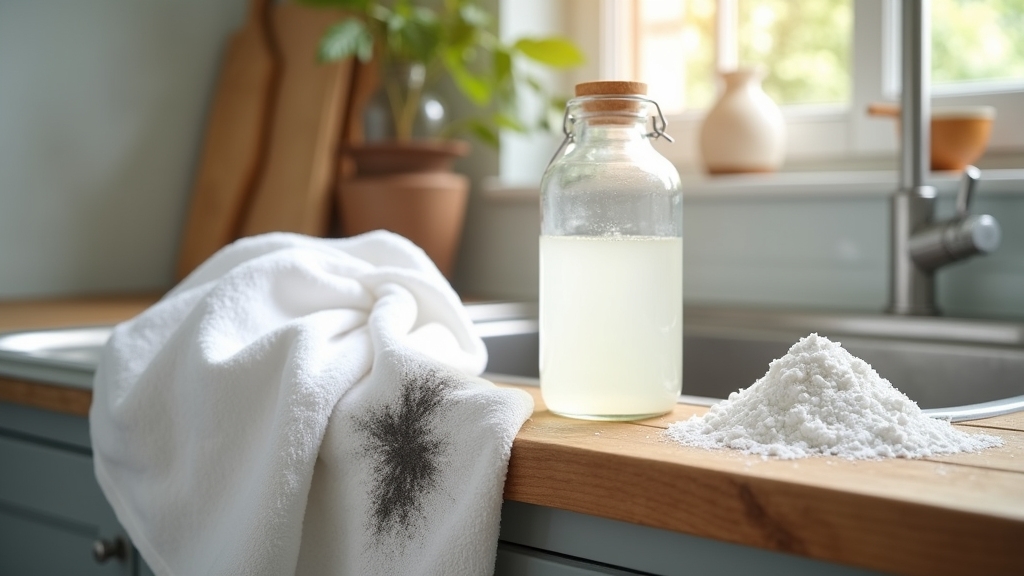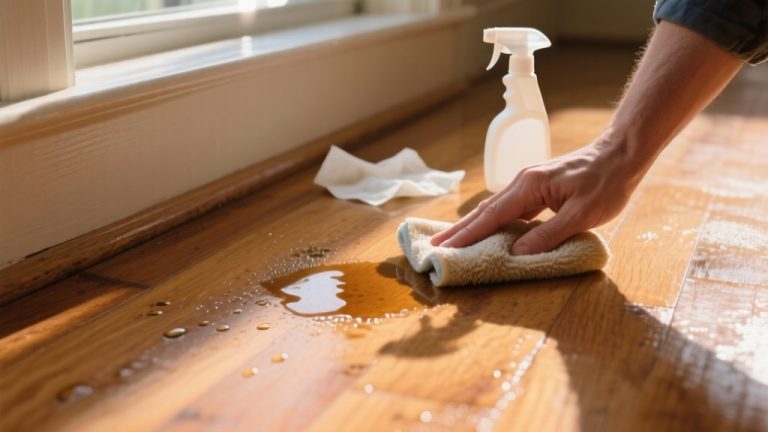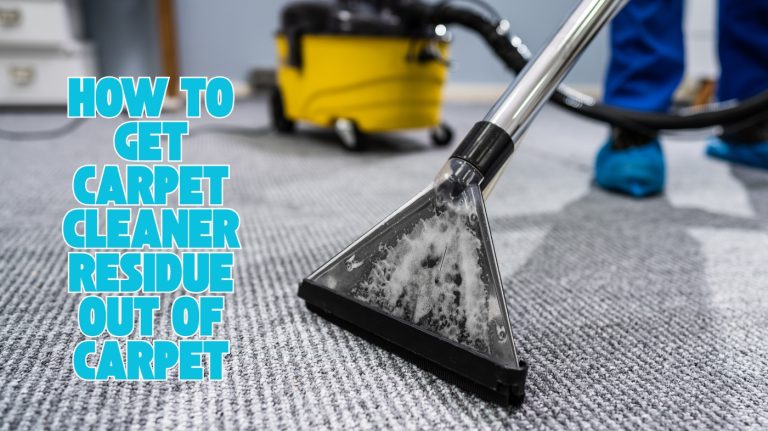How Do You Get Mold Out of a Towel: Right Cleaning Agents
To get mold out of a towel, first handle it carefully outdoors with gloves and a mask to avoid spreading spores. Brush off visible mold, then soak the towel in white vinegar or a diluted hydrogen peroxide solution for at least 30 minutes.
Wash it in hot water with added baking soda or bleach if the fabric allows. Dry thoroughly in direct sunlight or a hot dryer to prevent regrowth. These steps guarantee safety and effectiveness, and you can explore further methods for persistent mold issues.
Key Takeaways
- Handle moldy towels outdoors using gloves, goggles, and an N95 mask to prevent spore spread and contamination indoors.
- Brush off loose mold outdoors, then soak towels in undiluted white vinegar or a baking soda solution for at least 30-60 minutes.
- Wash towels in hot water (≥140°F/60°C) with added vinegar or diluted bleach, repeating if mold persists to ensure thorough cleaning.
- Dry towels completely using high heat in a dryer or by hanging in direct sunlight for 4–5 hours to kill remaining mold and prevent regrowth.
- Discard towels if mold covers over 50%, odors persist, or fabric is extensively damaged, sealing them in plastic bags for safe disposal.
Identifying Mold on Towels
Although mold on towels can sometimes be mistaken for mildew, you can identify it by its distinct fuzzy texture and colors like deep green, black, or red. Mold patches appear irregular and fuzzy, unlike mildew’s flat, powdery spots in white, gray, or brown.
You’ll often find mold in fabric folds, seams, or damp areas where moisture lingers, especially if towels are stored in humid, poorly ventilated spaces. Mold requires oxygen, moisture, and a food source to grow, which is why these conditions encourage its development.
Address these areas promptly to avoid unpleasant odors and further contamination. Mold spots may feel slimy when wet and crusty when dry, often accompanied by a musty odor.
Towels with mold can also feel damp, sticky, or stiff due to fungal penetration into fibers. Recognizing these precise visual and tactile signs early helps you prevent mold growth from worsening or spreading, protecting your towels and health.
Safe Handling and Initial Removal of Mold Spores
When dealing with moldy items, it’s really important to prioritize safety. So, make sure to wear protective gear—like gloves, goggles, and an N95 respirator. This will help keep you safe from any contact with those pesky mold spores during the removal process.
If you can, try to handle those moldy towels outdoors. This way, you can minimize the chances of spreading spores inside your home. Plus, it just makes the whole situation a bit easier to manage!
To prevent spores from migrating to unaffected areas, it’s advisable to establish containment around your workspace. Using ergonomic tools can also reduce physical strain while cleaning moldy fabrics.
Just remember, when you’re dealing with the towels, avoid shaking or agitating them. This will help reduce the risk of spores getting airborne and spreading even more. Stay safe out there!
Protective Gear Use
When handling mold-contaminated towels, wearing appropriate protective gear is essential to prevent exposure to harmful spores and cleaning chemicals.
Use long rubber gloves made of nitrile or neoprene to shield your skin. Protect your eyes with non-vented goggles or sealed eye protection to avoid irritation. An N95 or higher respirator filters airborne spores; choose P100 or half-face respirators for extensive exposure.
Disposable full-body coveralls, like Tyvek suits, prevent spores from contacting your skin and clothing. Disposable PPE is essential for effectively containing mold spores during cleanup.
Wear waterproof boots or protective footwear covers with slip-resistant soles to maintain safety. Ensure you clean and disinfect all reusable protective gear to avoid cross-contamination during subsequent uses.
Always opt for disposable PPE to prevent cross-contamination and dispose of it after use. Avoid touching moldy towels barehanded and conduct cleaning in well-ventilated areas to minimize spore inhalation and spread.
Outdoor Spore Removal
Since mold spores cling tightly to towel fibers, you must physically agitate the fabric outdoors to remove them effectively.
Use a stiff brush or shake the towel vigorously in a well-ventilated, sunny area to dislodge spores, preventing indoor air contamination. This is important because mold spores can stay airborne indefinitely when disturbed, increasing the risk of spreading indoors.
Performing this step outdoors also supports eco-conscious practices by avoiding indoor contamination. Lay a tarp beneath to capture debris and protect the surroundings.
Before agitation, coat moldy spots with diluted hydrogen peroxide or vinegar, letting it sit 10 minutes to disrupt spores. For persistent mold, apply a baking soda paste, allow drying, then scrub gently.
Use a HEPA vacuum on dry towels to capture airborne spores before washing. Collect dislodged residue in sealed bags, wear disposable gloves, and isolate the cleaning zone from traffic.
Afterward, decontaminate tools with bleach solution and dry towels thoroughly in sunlight to inhibit mold regrowth.
Pre-Treating Towels to Eliminate Mold
If you’ve got some moldy towels on your hands, don’t worry! You can easily pre-treat them to get rid of the mold. One effective method is to soak those towels in a solution of borax or hydrogen peroxide.
Just let them soak for at least 30 minutes to really deactivate those pesky mold spores. Before soaking, it’s a good idea to brush off visible spores carefully to reduce mold presence on the fabric.
Using gloves and working in a well-ventilated area is recommended to prevent cross-contamination during this process.
Another option is to spray the affected areas with a vinegar-water mixture or a diluted non-chlorine bleach solution. This targeted approach can really help with mold removal. Just remember to let it sit for about 10 to 20 minutes for the best results.
It’s important to stick to those treatment times to make sure you’re maximizing your mold elimination before you toss them in the wash. Happy cleaning!
Effective Soaking Solutions
Although mold can embed deeply in towel fibers, effective soaking solutions can substantially reduce and eliminate mold spores before washing.
Pre-soaking towels in appropriate solutions disrupts mold colonies, loosens stains, and enhances detergent action during washing. Choose a method compatible with your towel’s fabric and colorfastness.
Consider these key soaking strategies:
- Soak towels in undiluted white vinegar for at least one hour to kill mold spores and break down residues.
- Ensure you use the warmest safe water temperature to maximize the mold kill rate and avoid fabric damage.
- Combine baking soda and vinegar washes for enhanced mold removal and deodorization.
- Use a diluted bleach soak cautiously on bleach-safe fabrics to eradicate mold and stains. Always test a small hidden area first to prevent irreversible discoloration.
- Apply undiluted 3% hydrogen peroxide for 12–24 hours for tough mold spots, testing fabric compatibility first. Hydrogen peroxide lightens fabrics; avoid soaking darker-than-cream-colored textiles to prevent discoloration.
Always brush off loose mold outdoors and soak in the warmest safe water to maximize mold kill rate.
Safe Mold Removal Sprays
Begin by selecting a mold removal spray appropriate for your towel’s fabric. For bleach-safe cotton or polyester, dilute sodium hypochlorite bleach on a hidden spot to confirm colorfastness.
For heavier mold issues, allow extra time for the treatment to penetrate deeply without damaging fibers, similar to how deep cleaning methods require additional time to be effective.
For heavy mold, soak towels in ¼ cup bleach per gallon of cool water before laundering. If towels are delicate or colored, use oxygen-based bleaches like Clorox 2™, soaking about an hour to reduce mold spores without damaging fibers.
Natural sprays, such as diluted white vinegar, hydrogen peroxide (50/50 with water), or essential oils, offer antifungal benefits safely.
Always pre-clean visible mold, test sprays on a hidden area, wear gloves, and avoid skin contact. These measures optimize mold elimination while preserving towel quality.
Because mold and mildew germs can destroy surfaces they grow on, address mold thoroughly to maintain both hygiene and fabric integrity.
Treatment Duration Tips
When should you soak towels during mold treatment to maximize effectiveness? You should soak towels in an appropriate cleaning solution for at least 30 minutes to loosen mold spores and stains efficiently.
For best results, consider using natural and eco-friendly odor eliminators that are safe for fabrics and effective against mold.
For stubborn mold, extending soaking up to 60 minutes allows deeper penetration of agents like borax, hydrogen peroxide, vinegar, or bleach. Always verify fabric care labels to prevent damage from prolonged soaking.
Washing machines remove surface mold effectively but may not eliminate deeply embedded spores, so combining soaking with washing is crucial to ensure thorough cleaning surface mold removal.
Key treatment duration tips include:
- Soak towels 30–60 minutes depending on mold severity.
- Use hot water washes (≥140°F/60°C) post-soaking.
- Employ double wash cycles for heavily contaminated towels.
- Dry towels immediately using sunlight or high-heat dryers.
- Repeat soaking and washing within 24 hours if mold persists.
Following these precise durations prevents mold regrowth and ensures thorough decontamination.
Effective Washing Techniques for Moldy Towels

To effectively remove mold from towels, you need to prioritize washing methods that target mold spores at their source. Use the hottest water temperature safe for your towels, ideally 140°F (60°C) or higher, to kill spores efficiently.
This is crucial because dampness from incomplete drying creates an ideal environment for mold growth. Proper ventilation during drying also helps prevent mold from returning by reducing moisture buildup.
Run two consecutive hot water cycles to maximize mold elimination. Add 1 cup of white vinegar during the wash or rinse cycle to neutralize odors and break down mold.
For bleach-safe fabrics, use ⅓ cup chlorine bleach or oxygen bleach alternatives for delicate fibers to disinfect without damage. Incorporate ½ cup baking soda alongside detergent to remove odors and gently scrub mold stains.
Avoid detergent overuse to prevent residue buildup, which can harbor spores. Make certain your washing machine is clean and not overloaded to guarantee thorough rinsing and prevent cross-contamination.
Using enzymatic cleaners in some cases can also help break down organic residues that promote mold growth.
Best Practices for Drying Towels After Mold Treatment
When it comes to drying your towels after treating them for mold, it’s best to use the hottest dryer setting that your towels can handle. This really helps to get rid of any leftover mold spores effectively.
Using a dehumidifier indoors can also speed up the drying process by reducing moisture in the air. If you can, try to dry your towels outside in the sun! The UV rays are great at disinfecting and they can help with any lingering odors too.
Oh, and just a quick tip: make sure your towels are completely dry before you store them away. You definitely want to avoid leaving them damp or all bunched up, as that can lead to mold coming back.
Mold spores are microscopic and airborne, so thorough drying is essential to prevent their growth. Keeping your towels fresh and mold-free is all about that thorough drying!
Effective Dryer Settings
Although drying towels might seem straightforward, selecting the correct dryer settings is crucial for eliminating mold spores effectively. Always use the highest heat setting safe for your towel’s fabric, ideally above 60°C (140°F), to kill residual spores. Proper drying is essential because mold thrives in moisture.
Avoid medium or low heat, as they won’t ensure complete spore destruction. Opt for a sanitize cycle if your dryer has one, as it’s designed specifically for this purpose. Dry towels for at least 20 minutes continuously, ensuring they’re fully dry before removal.
If towels feel damp or cool, run an additional drying cycle. Key points to remember:
- Use highest recommended heat setting for towels
- Prefer sanitize cycle when available
- Dry for minimum 20 minutes per cycle
- Confirm towels are completely dry before removal
- Avoid low or medium heat settings
Sunlight Benefits
Selecting the appropriate dryer settings effectively kills mold spores. Incorporating sunlight exposure afterward enhances your towels’ cleanliness further.
Sunlight’s ultraviolet (UV) rays possess natural antifungal properties that reduce mold spores and mildew-causing microorganisms.
To maximize benefits, hang towels fully spread out in a well-ventilated outdoor area with direct sunlight for at least 4–5 hours. This practice also helps prevent mold growth by ensuring proper ventilation around the fabric.
This promotes even drying, prevents damp spots, and improves deodorization by breaking down odor-causing bacteria. Before hanging, shake off loose spores to increase UV exposure efficiency.
Although sunlight won’t completely sterilize towels, it complements thorough washing and drying by reducing microbial growth and mild stains. Monitor fabric care labels to avoid fading from prolonged exposure.
Consistent sun drying after mold treatment enhances freshness, inhibits mold resurgence, and supports towel longevity.
Moisture Prevention Methods
When towels are removed promptly from the washing machine, you considerably reduce the risk of bacterial and mold growth caused by lingering moisture.
To guarantee thorough drying after mold treatment, follow these best practices:
- Use the dryer’s hottest cycle and avoid overloading to guarantee complete drying.
- Hang towels unfolded in a well-ventilated area to maximize air exposure.
- Turn on exhaust fans and keep windows open to reduce bathroom humidity.
Air dry towels before placing them in laundry baskets to prevent trapped moisture. It is also important to store belongings in dry, ventilated spaces to further reduce mold risk.
Rewash towels if mold spots persist after initial cleaning to eliminate spores. Implementing these moisture prevention methods minimizes mold recurrence and maintains towel hygiene through effective drying techniques.
Preventing Mold Regrowth on Towels
To prevent mold from regrowing on towels, you must guarantee they dry completely after each use, as moisture is the primary factor that promotes mold development.
Hang towels in well-ventilated areas or use towel warmers to accelerate drying. Avoid folding or bunching wet towels, as trapped moisture fosters mold growth. Heated towel racks help decrease the frequency of washing towels, limiting mold potential.
Before washing, air-dry towels thoroughly to prevent dampness accumulation in laundry baskets. Wash towels regularly, ideally every three days in humid environments, to disrupt mold spores and organic residue.
Optimize bathroom ventilation by running exhaust fans and using dehumidifiers to control humidity. Install towel racks or hooks that allow airflow around each towel, keeping them away from walls and tiles.
Recommended Cleaning Agents for Mold Removal
Although mold can be stubborn, you can effectively eliminate it from towels using specific cleaning agents known for their antifungal properties. Selecting the right agent guarantees thorough disinfection and fabric safety. Here are the top recommended options:
- Hydrogen Peroxide: Use a 50/50 solution on affected areas; let sit 15 minutes before washing.
- White Vinegar: Spray equal parts vinegar and water; allow 15–20 minutes to kill over 80% of mold species.
- Bleach: Best for white towels; dilute per instructions; kills spores and disinfects fabric.
- Baking Soda: Add to washer with detergent; lifts stains and neutralizes odors; it is also important to use an additive like EC3 Laundry Additive to clean clothes from mold, bacteria, and toxins, helping prevent contamination transfer. EC3 Laundry Additive
- Essential Oils (Tea Tree, Lavender): Add a few drops to detergent; antimicrobial and eco-friendly.
Protecting Yourself During Mold Cleanup
Since mold spores pose significant health risks, you must wear appropriate protective gear before starting cleanup.
Use non-latex gloves, goggles without ventilation holes, and an N-95 respirator to prevent skin, eye, and respiratory exposure. Cover all skin with long sleeves, pants, and protective footwear to reduce contact and spore tracking.
Seal off the cleanup area with plastic sheeting and keep doors and windows closed to contain spores. It is important to contain the area effectively to prevent mold spread to other parts of the home.
Avoid using standard fans or vacuums; instead, use HEPA-filtered vacuums and damp wiping to minimize spore dispersal. Handle moldy towels carefully, placing them in disposable bags for removal.
After cleanup, thoroughly wash hands and exposed skin. If you have respiratory issues, avoid cleanup and seek professional help for extensive mold to ensure safety and effective remediation.
When to Dispose of Mold-Damaged Towels?
Whenever mold contamination on towels surpasses a certain threshold, you should consider disposal rather than cleaning.
Specifically, if mold covers more than 50% of the towel’s surface or if black mold (*Stachybotrys chartarum*) is present, discard the towel immediately.
Discard towels immediately if mold covers over 50% or if black mold is detected.
Persistent musty odors after repeated cleaning attempts also indicate deep mold penetration, requiring disposal. Consider these disposal indicators:
- Extensive mold coverage or black mold presence
- Structural damage like holes or fabric weakness
- Ongoing odor despite cleaning efforts
- Towels used by vulnerable individuals (babies, elderly, and immunocompromised)
- Long-term mold exposure beyond 48 hours
Mold spores can survive indefinitely until conditions trigger growth, so proper disposal prevents further contamination and health risks mold spores survival. Seal moldy towels in plastic bags and follow local regulations to prevent spore spread and protect health.
Maintaining Mold-Free Towels Long-Term
To keep your towels mold-free over time, you need to control moisture and guarantee proper drying and storage consistently.
Maintain bathroom humidity below 80% using exhaust fans and ventilation. Hang towels spread out after use, avoid folding damp towels, and wash regularly in hot water without fabric softeners.
Bathrooms and laundry rooms are common places where mold thrives due to high moisture levels. Store towels in well-ventilated areas, keeping them away from walls to enhance airflow. Replace old towels prone to mold retention.
| Aspect | Key Actions | Reason |
|---|---|---|
| Humidity Control | Use exhaust fans, open windows | Reduces moisture, prevents mold |
| Drying Practices | Spread towels, use heated racks | Accelerates drying, inhibits mold |
| Laundry | Hot water wash, avoid softeners | Eliminates spores, preserves fabric |
| Storage | Ventilated, spaced storage | Limits moisture buildup |
| Maintenance | Frequent washing, replace old | Prevents mold growth long-term |
Frequently Asked Questions
Can Mold on Towels Cause Allergic Reactions or Respiratory Issues?
Yes, mold on towels can cause allergic reactions and respiratory issues. When you use or inhale spores from moldy towels, you might experience skin irritation, sneezing, itchy eyes, or worsen asthma symptoms.
Prolonged exposure can trigger chronic respiratory problems and sensitization. To protect yourself, always dry towels thoroughly and wash them properly to prevent mold growth and reduce health risks linked to mold spores and toxins.
Is It Safe to Use Moldy Towels on Sensitive Skin or Babies?
Using moldy towels on sensitive skin or babies is like inviting invisible enemies into your safest space.
You shouldn’t use them; they harbor spores and bacteria that irritate skin, trigger allergies, and risk infections. Babies’ delicate barriers and your sensitive skin need uncontaminated towels.
Always choose freshly washed, thoroughly dried towels to protect health and prevent microbial invasion. Prioritize hygiene rigorously to keep skin safe and resilient.
How Long Can Mold Spores Survive on Towels Without Visible Mold?
Mold spores can survive on towels indefinitely in a dormant state, even without visible mold. They remain viable for months or years unless exposed to high heat, disinfectants, or drying conditions that kill or deactivate them.
You should avoid relying on appearance alone to assess contamination. To prevent growth, keep towels dry, wash them at temperatures above 60°C (140°F), and use disinfectants to guarantee spores don’t activate or spread.
Are There Natural Homemade Remedies to Prevent Towel Mold Between Washes?
Yes, you can prevent towel mold naturally between washes. Soak towels occasionally in diluted white vinegar or lemon juice to inhibit mold growth. Use essential oils like tea tree or thyme, diluted in water, as a spray to create a mold-resistant barrier.
Always dry towels thoroughly in sunlight or a well-ventilated space. Avoid leaving damp towels bunched up, and consider using a dehumidifier or exhaust fan to reduce bathroom humidity effectively.
Can Mold on Towels Spread to Other Bathroom Items or Surfaces?
Yes, mold on towels can definitely spread to other bathroom items and surfaces. When towels stay damp, mold spores transfer easily through contact or airborne particles, contaminating nearby fabrics, grout, and fixtures.
You should dry towels completely, isolate moldy ones, and clean surfaces regularly to prevent this. Proper ventilation and thorough cleaning reduce moisture and spore dispersal, limiting mold’s ability to spread throughout your bathroom environment.
Keep Your Towels Fresh, Safe, and Ready to Use – Every Time
Think of mold on your towel like a stubborn stain on your reputation. If you don’t tackle it quickly and thoroughly, it only worsens. Studies show that untreated towels can harbor millions of mold spores, risking your health.
By safely pre-treating, washing with the right agents, and drying towels completely, you prevent mold’s return. Remember, consistent care is your best defense. This ensures your towels stay clean, fresh, and safe every time you use them.







